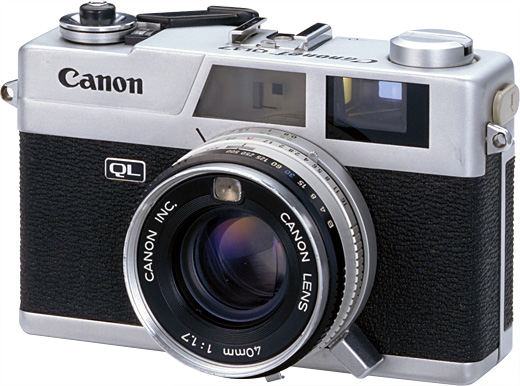
The first of a new Canonet series developed for compactness and lighter weight.
The camera was about 20 mm narrower, 4 mm shorter, and 30 percent lighter than the previous Canonet. To make it more compact, the lens focal length was shortened to 40mm, resulting in a wider angle lens. A Speedlite (Canolite D) which did away with complicated Guide No. calculations was also introduced. The flash aperture was set automatically to suit the flash output and subject distance. This was the fully-automatic flash system called CATS (Canon Auto Tuning System) incorporated for the first time.
With this feature, picture-taking with EE was completely automatic for both night and day.
New Canonet QL17-L(released in June 1970) was an improved version of the New Canonet QL17, this camera's viewfinder had a battery check zone near the f/5.6 mark. By pressing the battery check button, you could check the battery level in the viewfinder. Other specifications and features were the same as the New Canonet QL17. 'L' was for Luxury.
| Shutter | - |
| Viewfinder | - |
| - Magnification | - |
| - Coverage | - |
| Power | - |
| Size | - |
| Weight | -- |
The "new" Canonet QL17 sports a very fast 40mm f1.7 lens. The QL 17 and QL17 G-III are often referred to as the "poor man's Leica." A silent shooter, it incorporates many of the best rangefinder qualities but without interchangeable lenses. Shutter speeds range from Bulb to 1/500th and the aperture range is f1.7 to 16. It has a hotshoe which takes a very functional small flash which is great for fill light. The QL stands for quick loading, which is true. It was designed to use a 1.35 mercury cell which is no longer available. Many shooters will use a 1.4v Wein cell made for hearing aids that fits in the chamber. Some put a small rubber o-ring around the battery for a better fit. The downside of the Wein cell is that it lasts only about 3-4 months and is activated by air, so removing the battery does not extend its life. I have found that a 1.5v px625 works perfectly fine in the camera and does not affect the image or the camera. These batteries are cheaper and easier to find than the Wein cell and last a lot longer. I have shot positive film using this battery and get correct exposure every time. There is a handy check battery light and the aperture in camera display uses a simple needle. Basically the camera is either shot in aperture priority, automatic or manual. Due to age, most of these cameras have gummed up light seals which need to be removed and replaced. Kits are available for around $10 but there are plenty of videos for those that want to buy a "foamy" sheet and do it themselves. I replaced mine myself and it works great. If the internet is to be trusted many prefer the GIII version but the battery is harder to replace in my opinion as the px625 simply does not fit. I recently acquired a GIII model in great shape but have yet to shoot it. It is smaller and lighter than the excellent Yashica Electra 35 that many swear by. However, I find the viewfinder brighter in the QL17 and the focus lever keeps your hands out of the picture better. The Yashica takes a lot of practice whereas the Canonet does not. You can shoot film from 25-800 iso. I generally shoot 100 iso since the aperture range is very fast. The QL17 is cheaper to find online than the GIII and since the battery is easier to find I would purchase it before the GIII, Both have a self-timer if that is a requirement. It seems to be a 10 second timer. It makes for a nice little travel camera too.